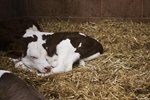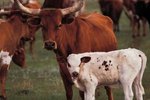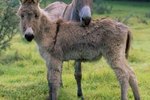In a healthy scenario, a ewe will take care of her lamb with very little intervention from you. If the ewe is ill or has died, if she has rejected the lamb, or if she cannot care for the lamb for another reason, you'll have to step in. With careful attention and the right supplies, you can raise a healthy lamb without the mother present.
Start With Colostrum
One of best things you can do for a newborn lamb is ensure that she receives colostrum, her mother's first milk, within the first 24 hours of life. The colostrum contains antibodies to protect against disease, delivers high-quality nutrients, aids digestion and helps warm the lamb from the inside. Lambs who do not receive colostrum are at a much higher risk for disease, hypothermia and death.
If possible, milk the mother shortly after birth and feed the lamb either by bottle or stomach tube as soon as possible, since a lamb's ability to absorb her mother's antibodies decreases rapidly over time. You can store unused colostrum in the refrigerator for 48 hours or in the freezer for up to 6 months.
If sheep colostrum is unavailable, substitute cow colostrum or a homemade diet you make by mixing 700 milliliters of cow's milk, one beaten egg yolk, 5 milliliters of cod liver oil and 15 grams of dextrose powder. Your lamb should ideally have three 100-milliliter colostrum or colostrum-substitute meals within the first 18 hours of life.
Keeping Warm
Hypothermia, a dangerously low body temperature, is a significant threat to newborn lambs. Newborn lambs often have difficulty regulating their own body temperature, and if hypothermia is not corrected, it may lead to death. If your lamb hunches up, appears weak, struggles to lift her head or has a rectal temperature of less than 100 degrees Fahrenheit, she may be suffering from this condition.
Warm milk or colostrum, either directly from the mother or warmed in a hot water bath, will help raise your lamb's internal temperature. Ensure that she is fully dry, wrap her in a towel, and use either heat lamps or hot water bottles to keep her warm. You can also use a warm bath to bring her temperature up, but do not use water warmer than 105 degrees Fahrenheit, as the sudden shock can be fatal.
After the first 24 hours after birth, it remains important to watch for signs of hypothermia. Provided the weather is not overly cold, simply keeping your lamb in a clean, draft-free area and ensuring she is fed regularly will typically keep her warm enough.
Feeding Your Lamb
After the first 24 to 48 hours during which you should feed colostrum, you can start feeding your lamb a milk replacer formulated for lambs. Hand-feed with a baby bottle or a soda bottle with a lamb nipple. You may have to place the nipple in the lamb's mouth and place several drops of milk on her tongue before she will start nursing. Warming the milk in a hot water bath may also encourage a lamb to start nursing in the beginning, but you should stick to chilled milk replacer as soon as possible to reduce the risk of bloat.
During the first two weeks of life, your lamb will need to eat at least four times a day. She should consume approximately 20 percent of her body weight in milk replacer each day. At 2 weeks of age, you can reduce feedings to between two and four times a day; consult your veterinarian to determine what is right for your lamb.
Preventing Illness
While ensuring that your lamb receives sheep colostrum in the first few hours of life is the best thing you can do to prevent disease, you can take other steps as well. Dipping the navel cord in iodine shortly after birth will help prevent infection and promote healing.
Maintain a clean environment and ensure that your lamb comes in contact only with lambs of similar age to prevent the spread of disease. Clean all bottles and nipples after every feeding, and chill milk replacer in the refrigerator immediately after preparing it to prevent bacteria that can cause fatal bloat in young lambs.
Your lamb will need vaccinations between 4 and 6 weeks of age. Talk to your veterinarian about the right vaccinations to give in your area.
Weaning Your Lamb
Keep fresh, clean water available for your lamb at all times. Start offering her access to creep feed, a high-quality mixture of grains that's at least 20 percent protein, after the first week. At 3 weeks of age, start offering high-quality forage in the form of hay or pasture; avoid using alfalfa, as this can lead to bloat.
While your lamb may not start eating and drinking on her own immediately, early offerings of solid food will speed the weaning process and help her rumen develop. You can wean your lamb once she starts regularly eating solids and reaches between 20 and 30 pounds, although the ideal weaning size may vary by breed. Your veterinarian may also recommend additional vitamins or minerals depending on the creep feed and forage you have available.
References
Photo Credits
-
David De Lossy/Photodisc/Getty Images





